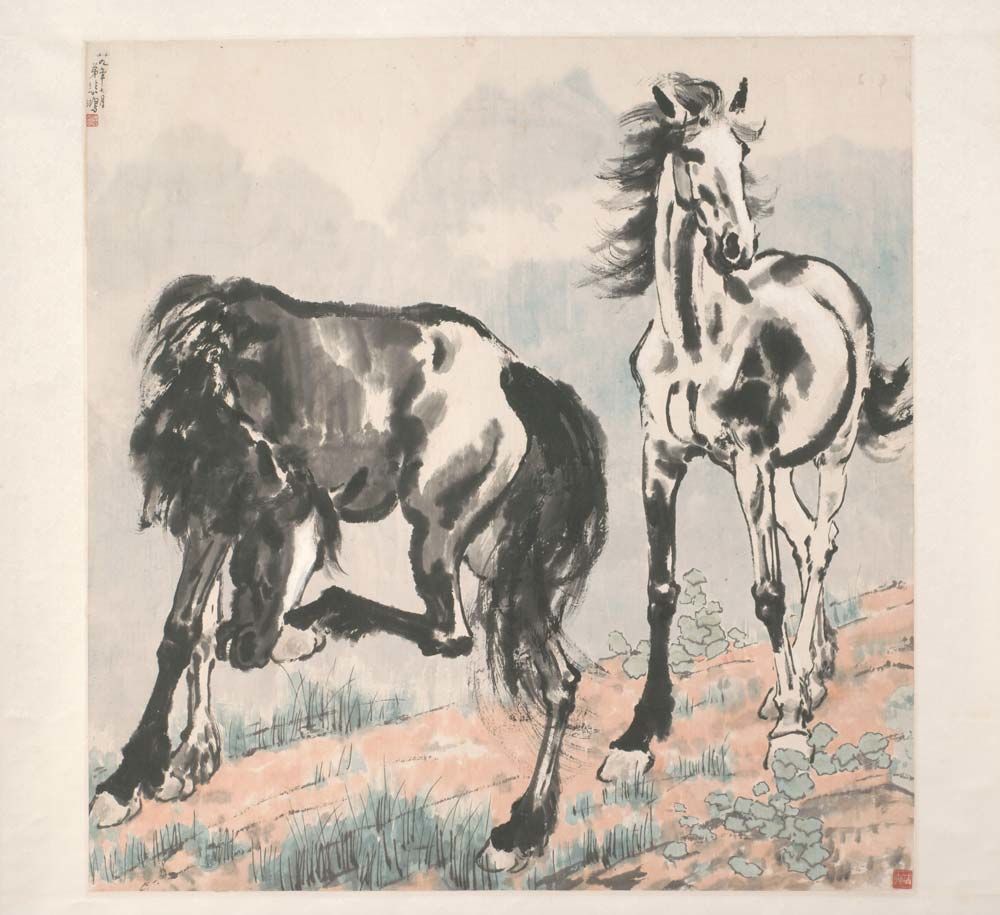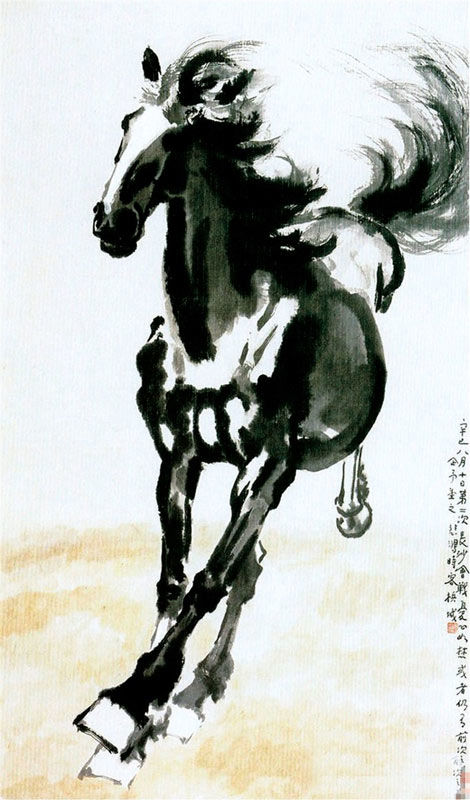Mention Chinese ink painting, and what comes to mind are perhaps idyllic illustrations of mountains and rivers, blossoms and trees. While these remain the traditional subject matter of Chinese painters, the 20th Century signalled not just a new era, but a new chapter in the history of Chinese art.
Modern Chinese art had arrived in the form of a galloping horse by renowned Chinese ink-and-wash painter, Xu Beihong (徐悲鸿, 1895–1953). Xu was touted as the “father of modern Chinese painting”, due to his combination of Chinese brush and ink techniques with a Western perspective and methods of composition. Motivated by people’s adoration for them, Xu went on to produce hordes of horse paintings. But beyond its sheer popularity, the horse has since occupied an important place in Chinese national history, for it symbolised China’s indomitable spirit in a time of war.
A Pair of Horses is a painting of two horses rendered in firm and bold brush strokes, depicting the strength and stability of this revered animal. The steed has been admired for its refined appearance due to its slender body and muscular legs, and it is an awe-inspiring and indispensable mode of travel that saw soldiers through battles. Going at an impressive speed also meant that it was a reliable form of escape.

This pair of horses is, however, portrayed in a different light, presenting their calm and peaceful side, a disposition that belies inner strength. To the right, one horse looks steadily out of the painting, casting a glance that stretches into an indeterminable distance beyond the viewer. This gaze speaks of quiet confidence, a firm assurance represented by how it has all its hooves squarely planted to the ground.
This interestingly contrasts with Xu’s better-known Galloping Horse painting that propelled him to fame. While the latter features a powerful horse in vigorous motion with hooves in the air, the former depicts a horse immovable, possessing unwavering faith and confidence. Against the backdrop of the ongoing war and widespread despair, these two seemingly contrasting depictions seem quite complementary, in that they display the attributes that the people so needed but could not summon. While the galloping horse cuts a dashing frame with its chest forward and mane and tail swept up by the wind, the standing horse exudes authority and dependability.

Its companion on the left of the painting, though obscured by darker shades, cannot go unnoticed. One’s first impression of this horse might be that of relaxed, unassuming, almost oblivious to its surroundings. And with that, one might be tempted to write it off. Why might Xu want to portray a horse in this incidental, unimpressive posture? Xu is known for incorporating social realism – a concern with the social and political hardships of the masses – into his work, a habit inspired by his study of Western art. Surely, then, his depiction of this horse in a state of repose must speak to more than simply idyll.
On closer look, the horse is bending its head, with one hoof raised to satisfy an itch. It is a gesture borne from tranquillity, reflecting an unhurried pace as compared to how this animal is commonly depicted as charging for battle. Here it is shown to be in a peaceful mood, a stark contrast to its companion which stands braced for battle. Perhaps, this “pair” of horses carries the complementary moods of present urgency and future longing. While the white horse steels itself for turbulence, its counterpart is a projection of the people’s hope for future peace.
A Pair of Horses, though one among many horse paintings, represents Xu’s aspirations for his nation and for Chinese art. Remaining true to his convictions about painting from real life experience, he harnessed the powerful symbol of the horse to evoke confidence and strength in a nation that was drowning in fear and despair. This is probably why his fame and influence continues to resound through the world of Chinese art to this day.
_______________________
A Pair of Horses is part of the collection of Dr Tan Tsze Chor, a wealthy businessman and Chinese art collector living in 20th Century Singapore. Along with 129 other Chinese Ink works, it is currently being exhibited at Living with Ink: The Collection of Dr Tan Tsze Chor at the Asian Civilisations Museum, ongoing until 26 April 2020.











